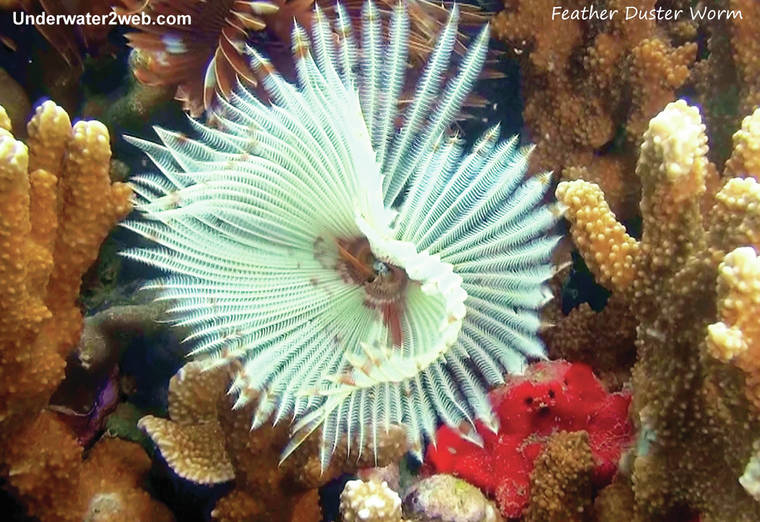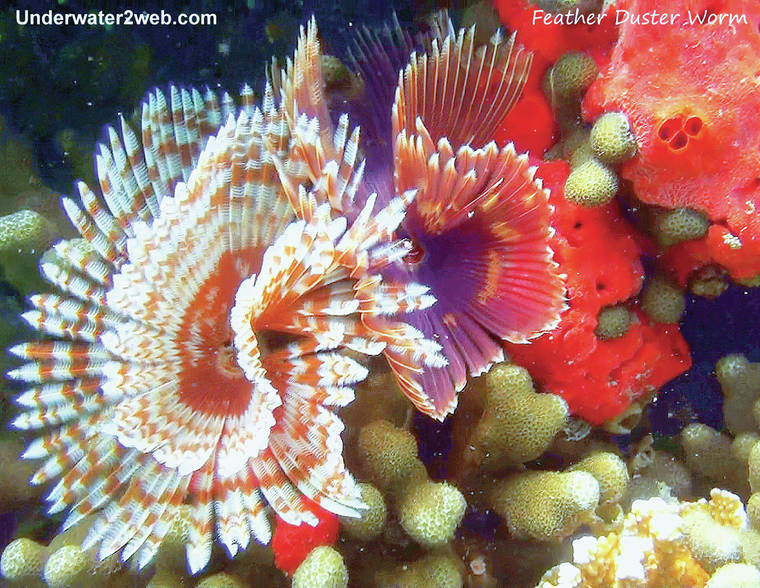We have some very crazy-looking marine worms that grow out on our Hawaiian coral reefs, and this one looks like the old feather duster hand broom that your grandmother used to clean the house with that was made from turkey feathers. The worm lives in a hard tube that grows right into the reef or corals, and when the worm is threatened it fully retracts into the tube that is barely visible to a diver going overhead.
When the worm wants to feed, it opens up out of its hard tube and fans out its crown, which looks like some beautiful bird tail feathers. This crown is used for breathing, like a set of fish gills, and is also used to filter-feed on suspended particles in the sea water. The feathery crown is soft and can get up to six inches across and come in an amazing array of colors, from purple, tan, golden to white.
Now you see it and now you don’t. With lightning speed the feather duster worm can retract into its tube home when threatened. Using slow-motion video, I recorded the worm retracting its crown in less than a tenth of a second.
How does the feather duster worm know to retract into its hard tube? For years I wanted to know how it monitors its environment, so I did some testing. The worm does not have eyes, and there are no visible sensory mechanisms or hairs on its crown. So how does it sense a threat? When you get close to the worm it retracts. Does it sense a change in light?
For my first test, I turned my dive light on and shined it at the extended crown from about three feet away and the worm did not retract,so the change in light did not cause it to react. I then slowly moved my hand towards the exposed crown and, sure enough, when I was about a foot away it retracted into the tube. So does the worm sense water movement? In my next experiment I took a piece of clear Plexiglas down diving with me and placed it between myself and the feather duster worm.
As I placed the plastic about a foot away from the worm it retracted. Within a few minutes the crown re appeared and the worm started filter-feeding normally. When I approached the worm this time the water movement from my hand was blocked by the piece of Plexiglas, but as soon as I got within a foot of the worm it retracted again!
Well, all of my experiments to try and figure out how these amazing worms can monitor threats in their environment failed, and I still do not know how they do it. These worms like to live in calm waters, usually in bays and under piers and jetties. I have watched them undulating in a current without retracting, and I have also seen them stay extended when a sea turtle or fish swam directly overhead, blocking out the light, so why do they retract when a human gets too close?
Nature is pretty amazing. All creatures underwater put out an electromagnetic field, so maybe the feather duster worm can detect a mild electrical current that is unusual in its ocean home. Humans did not evolve out on the coral reef, so we emit an “unnatural electrical current” that the worms may detect.
You can see the feather duster worm in action in the movie “The World’s Guide to Hawaiian Reef Creatures:” on the underwater educational web page, underwater2web.com, and also follow my online marine-science and home-school educational programs on my Facebook and Instagram under my name.
•••
Terry Lilley, a marine biologist, lives in Hanalei. His websites include underwater-2web.com and gofundme.com/5urrm4zw.



